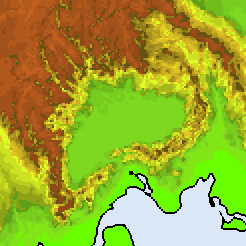History of Meó

The Meó came from the Proto-Meó-Succlythians, a people group who are theorised to have originated in the Khydean plateau and then split into two branches, the Meó in the Thazei basin, and the Succlythians in the Yot River catchment.
Under the Haki Republic
After the split of the Succlythian Empire in 7,224 Y, Emperor Lucclucc of the Southern Succlythian Empire declared himself the prophet of Luccluccism, stating that he had recieved divine right from the Elder Beings of Haki to conquer the entirety of Pavala in their name. He waged massive wars of conquest against the Meó, inhabitants of the Shattered Islands, the Northern Succlythian Empire and even parts of Nokhta, establishing the Haki Republic.
After an arduous 7 year campaign in the Htàzei basin (due to difficulties with supply routes and the large mountainous barriers around it), the ancient Meó capital of Loṅvintà was finally captured and subdued by Emperor Lucclucc, and with King Makihau executed, the Htàzei basin and Meó fell under the banner of the Haki Republic in 7256 Y.
The impact of the Haki Republic on Meó culture and society was enormous and permanently changed the region, bringing it from its former isolationist state to a region that for the rest of history would be deeply integrated with Htaevic and Succlythian society and customs. One of the most significant cultural impacts was the introduction of the Htaevic Hlunliw script, which had been adopted by the Succlythians and combined with some of their ancient mnemonic religious symbols, used to write in their language. Originally used for just Succlythian and Classical Htaevic writings, it was in the 7400s that the first Meó writings using the Hlunliw script appear, though these were scarce and of low prestige.
Meó under the Shattering
While the rest of the Haki Republic was in a general state of chaos due to the numerous civil wars, Meó remained relatively peaceful in this era, until the <invasion of the Khydeans in 7570 Y, which lasted until 7667 Y> (draftcy). The Meó, sick of the oppressive Khydean rule, staged an uprising against the Khydean overlords sieging their imperial palace in 7659 Y. This led to a civil war lasting from 7659 Y-7667 Y, largely along ethnic lines of the Khydean elite and Meó commoners - several Htaevic states sent military support to the Meó cause. The end result of the war was a Meó victory and the decimation of the Khydean royal class, with most surviving Khydeans fleeing back to their ancestral plateau. The following period, up until the mid 8600's Meó's history closely followed that of the 1024 Year Spring, with a flourishing of culture and politics. Due to the civil war earlier, a sense of Meó nationalism began to arise.
The War of the Prince Crab (9,349-9,358 Y)
Prince Vahketo [vɐx'ketu], establisher of the Kahla Dynasty, attempted to visit Prince Suakasui of Rvàshen in order to expand his diplomatic power to the south of the Malaeze Sea and attempt to increase the legitimacy to his claim of the Shattered Islands. Unfortunately, he achieved the exact opposite, by unknowingly eating the crown prince crab Azu. The irony of this was not lost on him, as Vahketo's own father had cannibalised in order to achieve his position on the throne of Meó. The result of this diplomatic skirmish was the start of a 9 years long war between Meó and the Unuvi princedoms, with millions of deaths. Meó also tries to take over the valley to the west or something.
The Discovery & Colonisation of the New World
Meó is hungry.
The Industrial Revolution
Meó discovers the power of coal and fun things and suddenly transforms into the Sichuan basin.
Space Age
Rocket time.